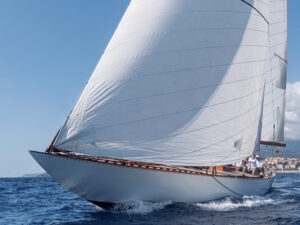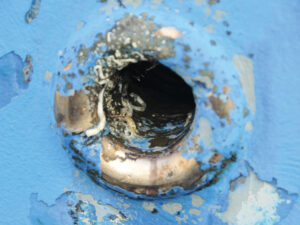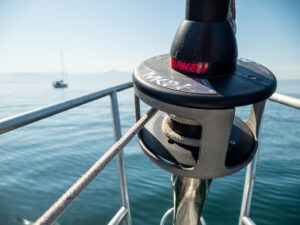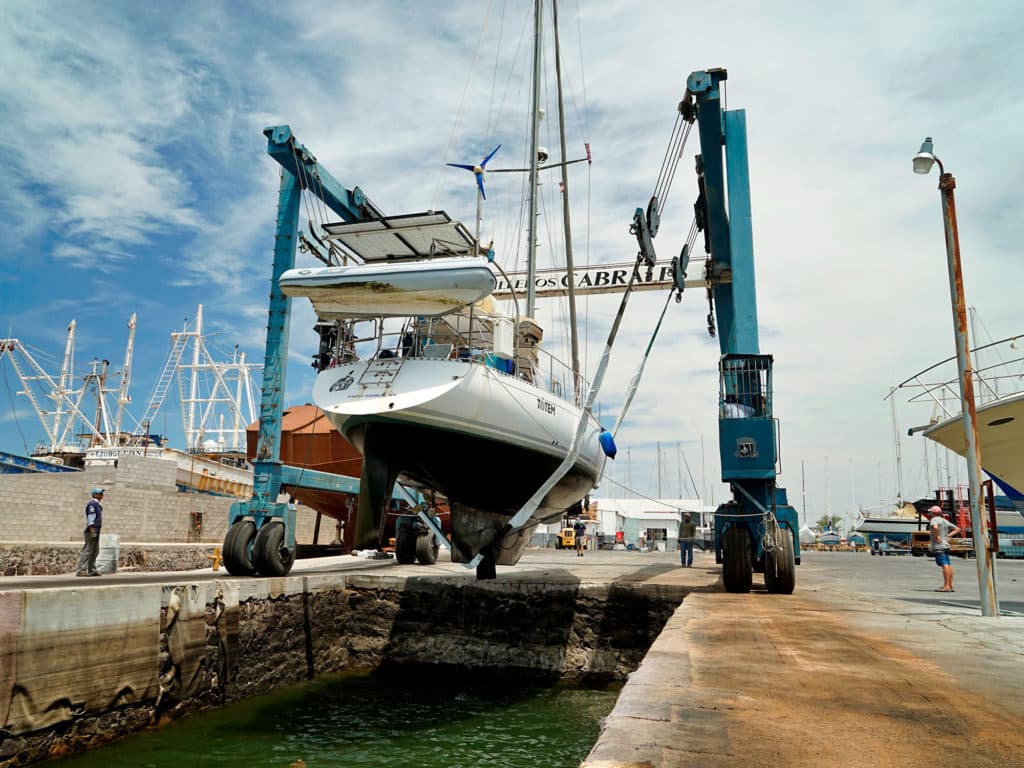
Leaving Puerto Peñasco’s harbor in our wake last December, I really expected it would be years—many years!—before we returned. But, 2020! Now we’re preparing to haul out at Cabrales Boatyard again. The hurricane-safe location offers us a chance to work on some minor projects for a couple of weeks, while readily accessing goods from the USA. Besides, yard manager Salvador and his wife Lara have a new baby girl that I want to meet! From a safe physical distance, of course (oh, that’s going to be hard! Not much beats fresh baby snuggles).
Meanwhile, other boats around us have started talking about plans to haul out there also. Some are ready for a break on land. Others have work that’s easier and more affordable to do at Cabrales compared to further south in Mexico. This is our third time hauling at Cabrales and sixth time hauling Totem, which leaves us with notes to share.
Local conditions
One of the reasons we like going up to Puerto Peñasco is—no hurricanes! There are gales though. Either way, know what harsh conditions affect the area and prepare as if they are certain to come. Whether big winds and reducing windage and perhaps extra jackstands makes sense. Big rain and you should make sure your cockpit scupper can’t clog. Or freezing temps – which are so far from Puerto Peñasco we’re not going to touch here!
Preparing the Engine
Initial engine preparation can be done while you’re still in the water, then a freshwater flush is all that’s left once you’re on the hardstand.
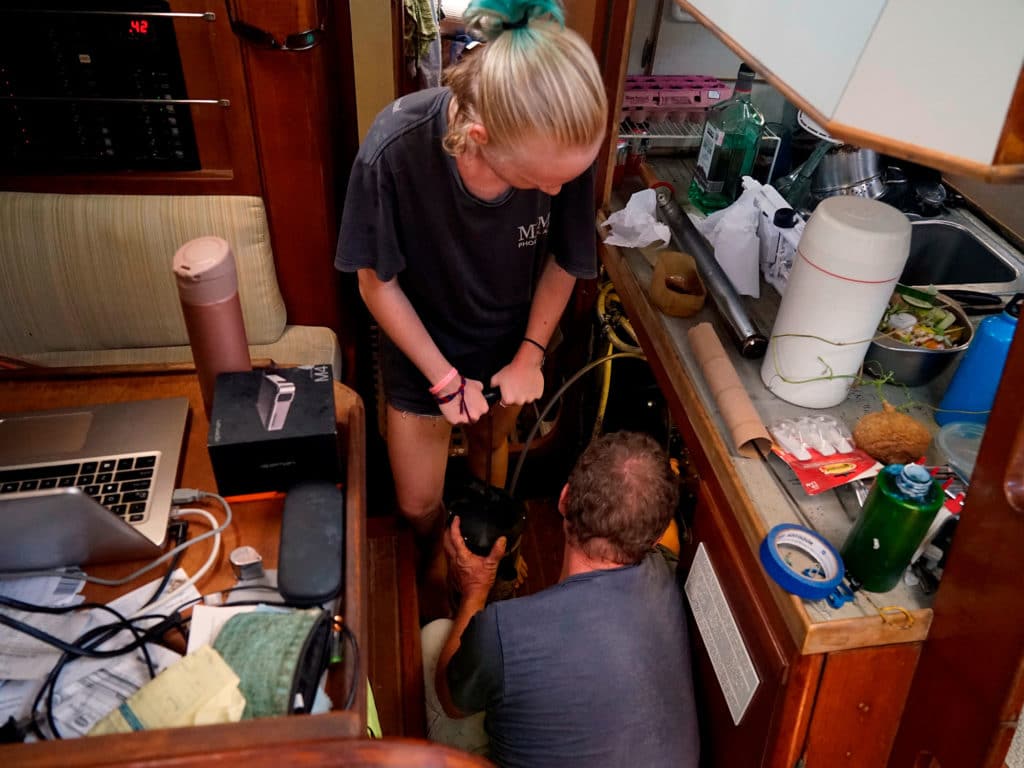
- Engine service: Check engine manufacturer service intervals. Is it at or near hours for a bigger service job? It’s nice to go back in the water with the engine in top condition.
- Basic maintenance: Unless recently changed, it’s best to replace consumables: engine oil, oil filter, transmission oil, impeller, alternator belt (if any wear), and fuel filters. Flush and replace the coolant, too.
- Fresh water flush: Seawater cooling system is very corrosive. Flushing with fresh water is easy is good for longevity.
- Remove the raw water hose from the seacock, then put into a 5-gallon bucket filled with fresh water. Have a land supplied water hose led to the bucket and ready to turn on.
- Start the engine and turn on hose, adjusting the flow rate to keep the bucket nearly full.
- Run for 5 to 10 minutes. When nearing completion, add a gallon of white vinegar to the bucket and turn off the hose; let this vinegar solution get pulled into the engine. Acetic acid in the vinegar dissolves some accumulated minerals inside.
- Make sure the engine goes off BEFORE the bucket empties!
Lightening the Load
Totem has 605 square feet of bottom and weighs in around 38,000 lbs. That’s a lot of mass taken almost entirely by the keel, balanced by jack stands. Emptying tanks and offloading anchor gear provides nearly 10% weight savings.
- Diesel tanks: Some favor full tanks for storing; less room for moisture that can enable diesel bug growth. We prefer to treat diesel with biocide (we’ve used BioborJF) and run the fuel down in the tank for less weight aboard. Diesel weighs about 7 lbs/gallon; big tanks mean big weight on the hull. One scenario when weight is a benefit is catamarans hauled out in high hurricane-risk areas.
- Water tanks: If not living aboard, then empty water tanks (excepting catamarans as above). When near empty add vinegar to the tank and run through fresh water system, including hot water tank to prevent growth.
- Holding tanks: Empty! Flush toilets with a water and white vinegar mix to prevent the swamp monster from eating your boat.
- Anchors and chain: We offload these high mass items to a pallet below Totem. She sighs when 450′ of chain and three anchors reach the ground.
Sails and Rigging
- Sails: If you’ll be away for an extended period, sails should come down for storage in a dry place out of the elements. Less sun and wind exposure equals longer life. For shorter periods, it’s more of a judgement call based on the risk of high winds or rodents/birds taking up residence.
- Standing rigging: Ease rig tension.
- Wash turnbuckles with fresh water
- Mark threads so you know how to tune
- Remove cotter pins and back off tension until at slight-tension (not sloppy), then put cotter pins in place
- Shut down the boom motel: birds love to live inside the boom. Stuff rags in the ends to prevent.
Preparing the Exterior
Puerto Peñasco is dusty! When the wind is up, fine dust reaches winch innards, sheave pins and other moving parts that don’t benefit from grit. Boats left for long-term storage can be shrink-wrapped to help protect them from the sand that blows in.
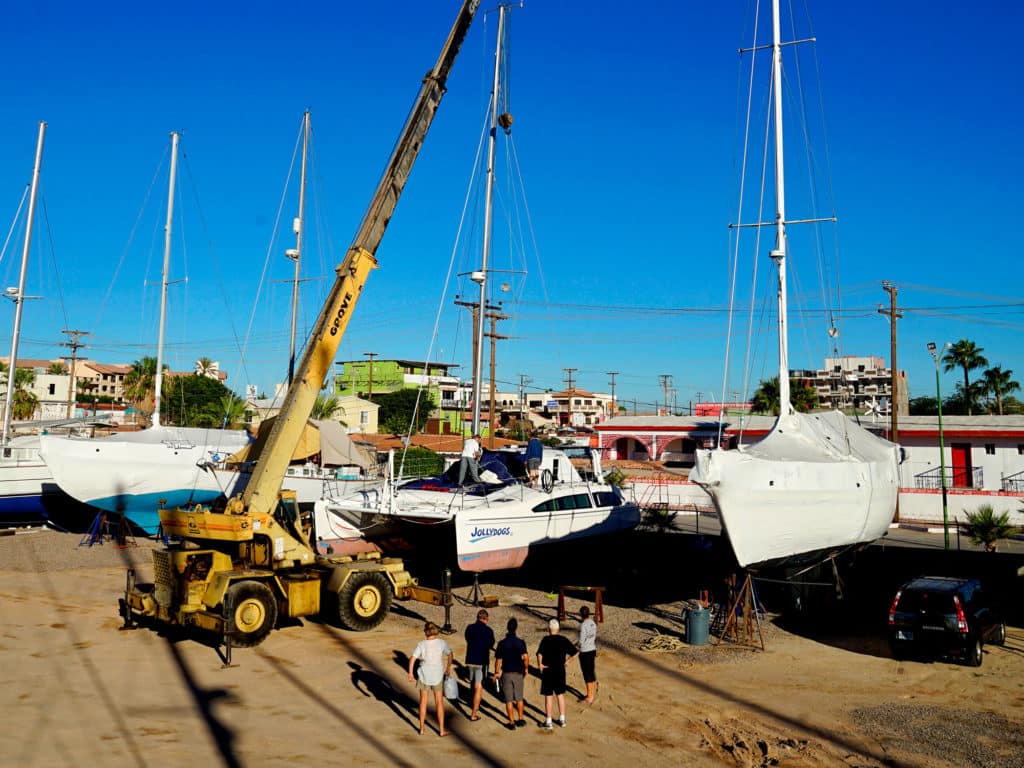
A common cover technique is aluminum foil wrap. In hot dry places like Puerto Peñasco the foil bonded to what it covered. Now we start with a wrap in thin cloth, then foil, and finish with duct tape to ensure it stays in place.
- Deck hardware: Start with a good deck wash to remove salt and dirt. Then cover moving parts: winches, clutches, blocks, and plastic hardware. Cover as much as possible for dirt and UV protection.
- Outside electronics: Cover! Including GPS and other more easily accessible antennas.
- Wind turbine: secure the blade from spinning and cover the unit to protect from dirt and UV.
- Rudder: rudders are a sealed piece, and when stored in a hot environment, the interior may expand to the extent that it causes damage—cracks that can lead to water intrusion. We don’t see these protected often, but it’s a good idea (see wrap on Kenta Anae, below).
- Everything else: In high-risk hurricane areas, assess every piece of hardware and every item affixed to the boat in terms of possible windage and consider removing them.
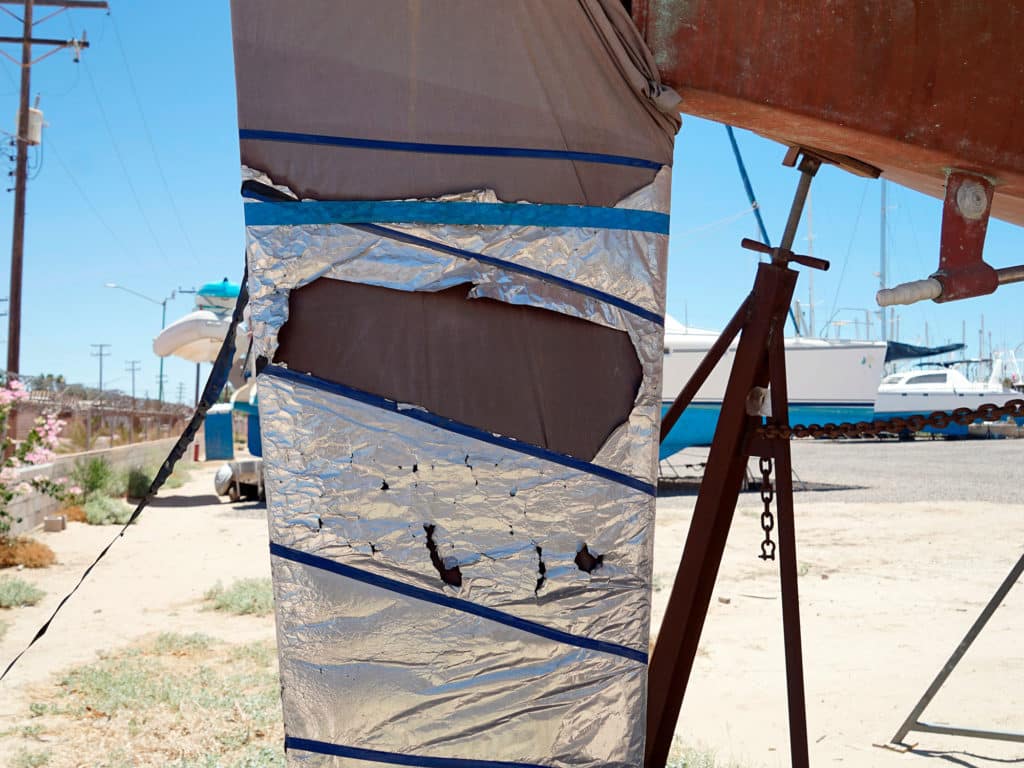
Power/ Electrical System
When we were in Malaysia a boat down the dock had a neighbor minding it while the owner was away for months. One day she asked for help dealing with a strong odor: Jamie cracked the sliding doors and nearly got smoked out. The batteries had boiled off their water, were super-hot and bulging. After carefully venting hydrogen sulfide gas from the cabin, he disconnected the batteries. A potential disaster, averted.
- Shore power: If not living aboard, we disconnect shore power that could have a power loss or spike that upsets onboard systems.
- Boat batteries: Our solar panels keep the batteries topped up. We have AGM batteries (for now) that don’t require water or other maintenance. Do know your batteries’ maintenance needs? Arrange with the boatyard or a cruiser to manage in your absence if required.
- Other batteries: The myriad of electronics we own often have batteries that may be best stored in a cooler environment. Lithium batteries don’t love high heat, and a closed-up boat in Mexican summer can exceed 160F, which may cause damage. Remove batteries from devices and store in a cooler spot if possible, and expect to replace.
Preparing the Interior
Puerto Peñasco is very dry during summer months. When Totem was going to be closed up tight during a three-month absence in 2018, we added about 10 gallons of fresh water into the bilge (with a cup of white vinegar to prevent growth). We were concerned that the dryness would shrink cabin sole planks and other wood parts. We worried the water would make it humid enough to cause other issues, but we tried anyway. On return we found most water evaporated, the wood fine, and no mildew problem.
- Leave the interior clean. Returning to a dirty boat is no fun!
- Wiping all surfaces with a vinegar/water solution from a spray bottle (or straight vinegar on a rag) kills the mold spores you don’t see yet to prevent them from blooming in your absence.
- Fine sand and dust that can cover the deck hardware, may get inside—even in closed-up boats. Consider covering harder-to-clean items like books and settee cushions with sheets.
- We left clothes in lockers and aired them out on return. Others swear by packing them in plastic bags, but be certain they are 100% bone dry first. An old school suggestion is to throw a dryer sheet in the bags but I find them toxic with a “fragrance” that makes me sneeze!
- Just before leaving the boat, we open all lockers and bilge access covers to improve air circulation.
Preventing Vermin
Cockroaches and rats love boatyards! We’ve gotten a rat in nearly every boatyard except Cabrales. Start by assuming their presence and take action to avoid some of the rat stories that are to icky to include here.
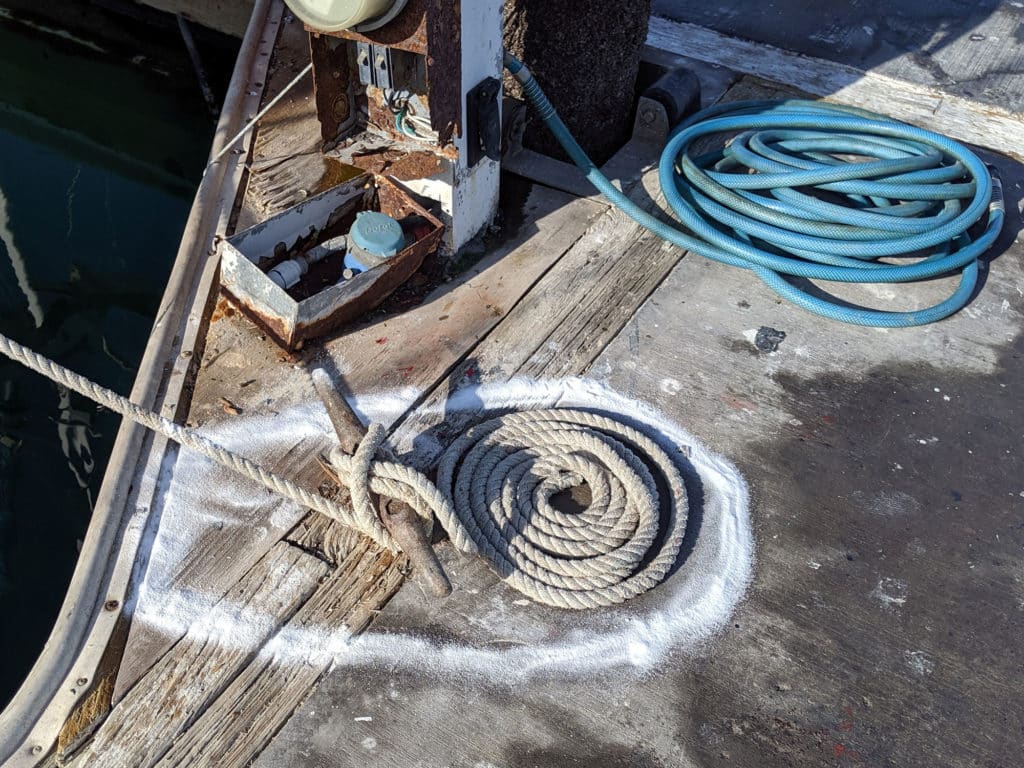
- Access: we don’t have an airtight boat (solar powered dorades fans keep turning!), and don’t want to—that doesn’t mean there’s a welcome mat out.
- Ports, hatches, and companionway are closed up.
- Bronze wool (steel wool rusts) or sponges block vents and through-hulls that may enable a pathway in otherwise.
- Rats are amazing climbers. Prior to leaving get rid of the ladder; and an inverted funnel around a power cord will dissuade any climbers (they may laugh at this attempt!).
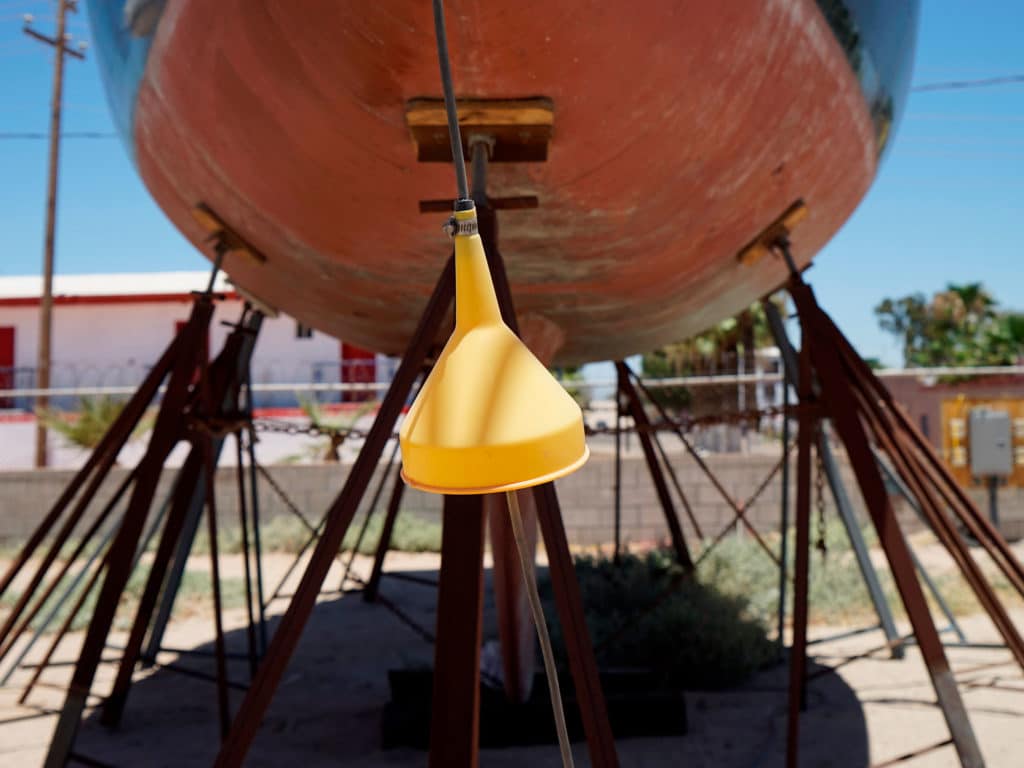
- Temptations: bugs and rodents have a single focus: food. Remove perishables and as best you can, non-perishables (see below), so as not to lure any critters to come aboard or linger.
- Deterrent measures: we put cockroach bait/poison in places they are likely to lurk. In Mexico, I buy a boric acid paste and smear it in suspect areas (caution if there are young kids or pets aboard). Sprinkling straight-up boric acid powder can do the same; best mixed with something to sweeten it to bug-yummy goodness (powdered sugar to stay powdery, sweetened condensed milk if you’d like a paste).
Heat Mitigation
We’ve recorded deck temperatures at 160°F! Below deck, the boat is literally an oven.
- Deck covers: Shading makes a big difference, but keep weather conditions in mind. High UV degrades plastic tarps in a couple months; and a wind event can flog them to shreds. We bought rolls of inexpensive UV shade material, with 80% sunblock to shade and allow airflow. Secure low and tight over lifelines and supporting lines like a “ridgepole” between mast and the bow.
- Ventilation: Stagnant air makes it hotter below and more likely enable mildew and mold growth. Some boats are tighter than others and may need dessicating agents like Damp-Rid inside, even in the dry heat. Totem’s solar vents keep turning over air and help prevent mildew below.
- Air conditioning: In extreme heat, consider installing a household air conditioner in a hatch or the companionway, and plugged in to a land-based power source. When we did this in Peñasco, it didn’t make it cozy and cool below, but it did take the edge off extreme heat.
Packing Out
- Remove all foodstuff: Almost. Perishables of course—but even most non-perishables. First, because ANY food is a lure for vermin. Second, because enclosed conditions below can be tough on even long-life goods. In Peñasco’s extreme summertime heat canned food could explode, then rot until cleaned week (months?) later.
- Packaged foods can be stored a larger sealed container or tub. I’d go as far as taping seams on a heavy-duty tub with a gasketed lid.
- Close propane tank valves.
- Gas in jerry cans doesn’t store well and is hazardous. Consider giving it to launching cruiser or local for the karma win!
Preparing for In-water vs. Hauling
The focus here is dry storage (and warm locations), but storing a boat in-water is sometimes a preferable option. In areas of extreme heat, remaining in-water is gentler on the boat than hot, hot air. In the summer of 2009, we stored Totem for about three months at a berth in San Carlos, Mexico. On the mainland side of Mexico, this area remains prone to hurricane risk.
Our preparations to keep Totem safe in-water were twofold:
- Reducing windage: sails off and below, along with just about everything not permanently attached to the deck (including our kayak)
- Securing well: we macraméd Kenta to the dock structure
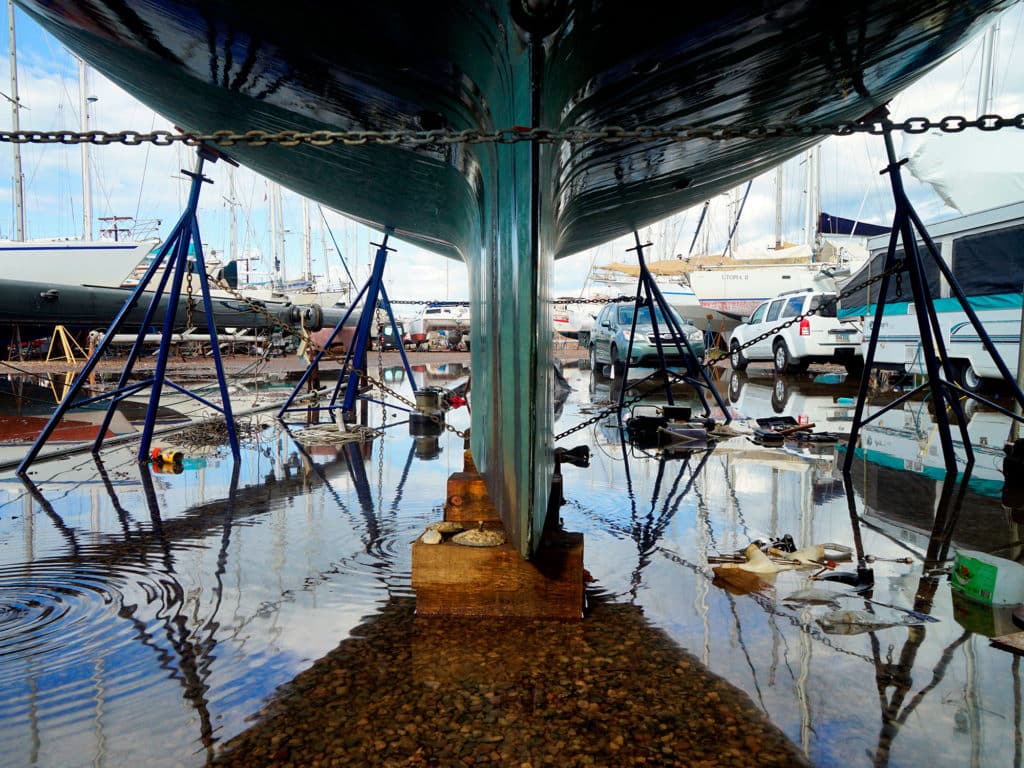
Remnants of Hurricane Jimena passed over the area with some bluster and epic rainfall, but Totem did perfectly fine in her slip. Ironically, a number of boats on shore were washed off jackstands due to flooding.

